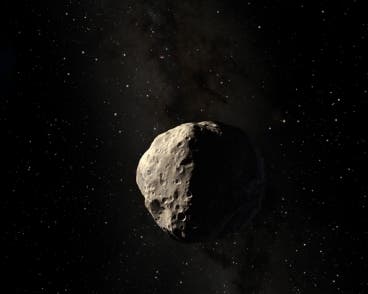
Artist impression of the Apophis asteroid.
No, this isn’t one of those misleading headlines. A MIT graduate student has recently proposed that bombarding an asteroid’s surface with paintballs could throw it off course from a possible collision orbit with our planet, by harnessing solar pressure.
The paintball cloud would hit the targeted asteroid and cover it in paint – white paint to be more specific. The pellets would cover the space rock’s surface as much as possible, doubling the amount of reflected sunlight. This, coupled with the slight orbit deviation from the pellet impact, would avert the threat of an asteroid impact, according to Sung Wook Paek’s computations.
Paek tested out his theory and ran a simulation on the asteroid Apophis, a 270 meter wide space rock often cited as a possible Earth colliding body sometime in the following decades. The next time it will pass Earth is 2029, and again in 2036. Apparently, 5 tones of paint would be required to roughly cover all of Apophis’ surface. Don’t imagine, however, that this method would immediately nudge such a huge asteroid. According to Paek, it would take 20 years for solar radiation pressure to successfully pull it off its Earth-bound trajectory.
It sounds like an interesting, maybe even viable option, if follow-up studies confirm the results, for pulling asteroids that might end up on a potentially threatening collision orbit with Earth in the following decades. It’s a lot safer than using nukes, like some papers and Hollywood proposed in the past. Other proposed solutions include gravity tractors, laser beams or impactors.
Paek says that other substances could be used for the pellets, besides paint, like aerosols that would “impart air drag on the incoming asteroid to slow it down,” he said in a statement. “Or you could just paint the asteroid so you can track it more easily with telescopes on Earth. So there are other uses for this method.”
Check out this MIT video below to see how this tactic would work:
Lindley Johnson, program manager for NASA’s Near Earth Objects Observation Program, believes Paek’s proposal is ‘an innovative variation’ on a method already used by others to exploit solar radiation pressure, like the Messenger spacecraft, which is currently orbiting Mercury. The spacecraft is equipped with solar sails that propel the craft with solar radiation pressure, reducing the fuel needed to power it.
“It is very important that we develop and test a few deflection techniques sufficiently so that we know we have a viable ‘toolbox’ of deflection capabilities to implement when we inevitably discover an asteroid on an impact trajectory,” he says.









